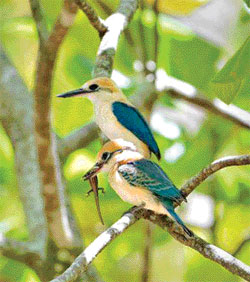|
Saving one of the
world's most endangered birds
The Tuamotu Kingfisher is a multicolored, tropical bird with bright
blue feathers, a dusty orange head, and a bright green back. The entire
population of these birds -- less than 125 -- lives on one tiny island
in the south Pacific, and without serious intervention, they will no
longer exist.
One University of Missouri researcher is trying to stop the birds'
extinction by working with farmers and residents on the island inhabited
by the kingfishers.
"If we lose these birds, we lose 50,000 years of uniqueness and
evolution," said Dylan Kesler, assistant professor in fisheries and
wildlife at the University of Missouri's School of Natural Resources in
the College of Agriculture, Food and Natural Resources. "Because it has
lived in isolation for a very long time, it's unlike any other bird.
There is no other bird like this on the planet."
|

Tuamotu Kingfisher |
In new studies published in the journal The Auk (published by the
American Ornithologists Union) and the Journal of Wildlife Management,
Kesler and his team of researchers have uncovered important information
to help ensure the birds' survival and a unique way to attach radio
transmitters to the birds to track them.To survive, the kingfishers need
several specific habitat characteristics:
* Hunting Perches about five feet off the ground -- The birds hunt by
"pouncing." They watch their prey and then fall on them from hunting
perches about five feet high.
Without the perches in broadleaf trees at the appropriate height, the
birds have no way to hunt.
* Exposed ground -- the birds' food con-
sists mainly of lizards, which are easier to spot where the ground is
clear of vegetation. When coconut farmers conduct intermediate burns on
their land -- which are hot enough to kill brush, but do not lead to
widespread fires or kill the lizards -- it exposes more ground and the
birds can see the lizards.
* Dead trees for nesting -- the birds create nests by flying into
dead trees and hollowing cavities. Live trees are too hard and many
farmers cut down their dead coconut trees. By encouraging farmers to
leave some dead trees, the birds will continue to be able to build
nests.
* Lessening the impact of predators -- cats and rats, which were
introduced to the island by humans, now hunt the Tuamotu Kingfisher.
"Unfortunately, even with all our work to date, the population is
still crashing," Kesler said. "We're seeing some turnover, but each year
when we return, there are more empty territories and the population
decreases. At this rate, these birds will be gone within our lifetime."
-ScienceDaily |

